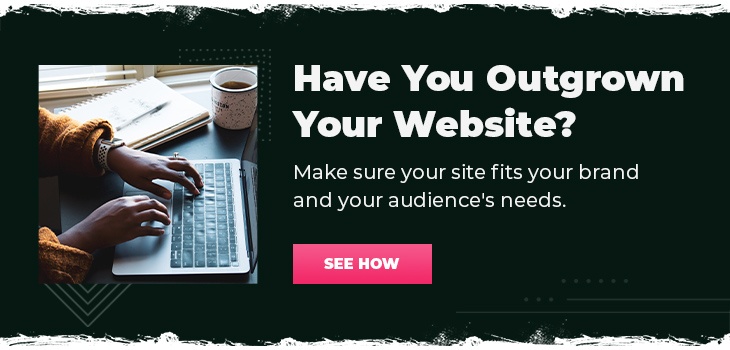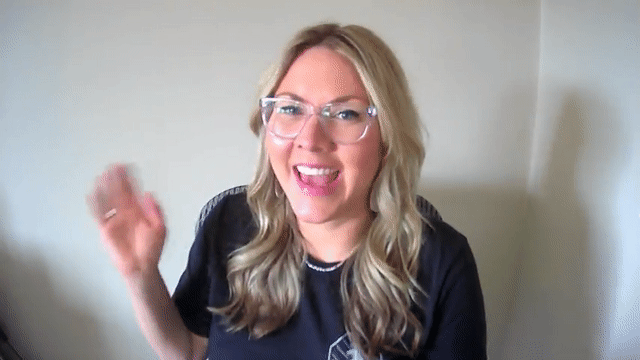Looking for bonuses that actually pay off? Check out these florida online casinos.
Here in our [figurative] office, we have some team members who are admittedly obsessed with coffee. Our Brand Strategist, Frank, even has a section in his notetaking app dedicated to the preferred brewing method for each of his favorite roasts.But others on our team are just looking for a good, hot cup of caffeine in the morning. They might have a preferred roast, but mostly they just want the comfort and pick-me-up of a nice cup of coffee.
I’ve found that a lot of businesses look at their website like most of our team views coffee: a key part of operating during the day, but not something you’re going to drill down and work to perfect.
[Let us pause for a moment and appreciate this killer metaphor I came up with without our copywriter’s help.]
Anyway, the point is, if you want your website to do more than sit around and serve as a digital business card, you need to treat it more like Frank does coffee — less like a chore, more like an art and science. That means you’re constantly evaluating user data and optimizing your content, website design and offers to better connect with potential leads and customers.
If you want a website that generates leads, you need three things: traffic, valuable content and a nurture strategy. Let’s dig in.
Step 1: Use SEO to Generate More Traffic
If you want to convert visitors into leads and customers, you first need to get prospects to visit your site. And the more traffic you can get to your site, the more data you have on what users are doing on your site, which means you can do a much better job of optimizing your content and design to meet their needs, thus, improving your conversion rate!).
There are a lot of ways to generate traffic to your site, including paid ads, directory listings and press releases. But if you want to garner traffic that will stick around, you need a really solid SEO strategy.
SEO (search engine optimization) is the process of optimizing content in a way that makes it easy for search engines (mainly Google) to find and serve to your users.
The trick to SEO is providing relevant content that meets the need that compelled the user to start their search. Honestly, this could be a whole other article but suffice it to say, the first step to turning your website into a lead-generating machine is to produce and optimize content that your website visitors would find valuable.
And while we are on the topic of getting more website visitors to your site, quality leads come from quality traffic. So make sure that you are optimizing content that will bring potential customers to your site, not just anyone who is searching the internet.
Google’s algorithm also takes into account your site’s organization and performance. If your pages are taking too long to load or if they aren’t organized in a skimmable hierarchy with the proper headings, Google will ding your rankings for providing a poor user experience.
So now what? Here’s what you need to do to get a handle on SEO for your site
- Create a keyword strategy and content calendar to produce optimized articles for your brand.
- Use a tool like Google’s lighthouse report or Ahrefs to identify key areas that need to be improved in your site’s performance.
- Check your pages to make sure there is an H1 heading tag and that the rest of the headings are organized like an outline would be and that they use the appropriate H tags in order of performance.
Step 2: Building Trust Through Valuable Content
If you want a website that converts users into leads, you have to offer valuable content.
No fluff. No thinly veiled sales pitches.
Real value.
This idea of attracting potential leads to your website is core to the inbound marketing methodology (read more about that here). It’s the idea that you don’t have to rely on “interruptive” methods like ads and billboards as your primary source of new customers. By creating valuable content that answers questions your leads are asking, you can “attract” them to your brand.
Qualifying “valuable content” can get a bit squirrely so let me share with you the three ways I qualify what is actually valuable for customers.
Offer as Much or as Little Content as Your User Wants
When a user first hits your site, they are going to start scrolling and skimming through your homepage to get an idea of what you offer and if it could solve for their pain points. But then what?
The more expensive and hands-on your service is, the more likely it is that the user will want to dig deeper once they initially qualify you. They might want to know more about your process, or what is included in your service, or what other services you offer that might complement their initial need. They might want pricing or they might want to get a sense of your company culture and values.
You can better understand what your user wants by testing new content and pages, and evaluating the engagement on them. You can also survey existing customers to inform your decisions or use a marketing tool with A/B testing to try different CTAs and landing page layouts to see what resonates best with your website visitors.
Regardless, you want to make information accessible on your site, while still making it easy for users to navigate to what they want or need to make a decision. You don’t want it to feel like a corn maze; you want it to feel like window shopping. They can glance through different things and then dig in a little deeper when they see something that piques their interest.
How do you create a skimmable, yet robust website?
- Use clear headers and subheaders to get the main idea across quickly.
- Create simple navigation and then create inner pages that allow the user to continue exploring topics in greater detail.
- Leave white space in your web design to allow the eye to rest and not overwhelm the user with text.
Meet Them Where They’re At
No matter where your customer is in their journey, you need to find out where they prefer to consume information and how they want to consume that information.
Not every audience likes reading blog articles or free ebooks. Maybe your target audience loves podcasts’ or maybe they are on social media throughout the day. They might prefer learning through a webinar or a YouTube video. To further complicate it, their preferences might change depending on their stage in the buyer’s journey. Perhaps they listen to podcasts every day as part of their routine and so that is a good place to provide “awareness” level content. Then they might prefer a Google search when they are looking for a specific service, or they may need a case study or white paper to seal the deal. Maybe they prefer articles for how-to topics but want to watch a video for new ideas and innovation.
Whatever it is, you need to find the channels where they’d prefer to meet you and offer content there.
Keep in mind that you might have different audiences for different products, and they might interact in different channels. They’re likely looking for different content topics too, so make sure to consider that as you lay out your content marketing strategy.
Not sure where to start? Try using this content-user match formula we use to determine what type of content is right for your audience and where that content should live. Let’s start with the ‘what.’.
What Type of Content Is Right for Your Audience?
This starts with answering two key questions around your target audience:
- Who is the ideal user or customer? The answer to this question should help you better understand the mindset of the audience you want to attract through your content. If you’re in the B2B space, for example, this should define things like the role that individual has within their company and some of their primary responsibilities.
- What does that individual need to do their job better as it relates to your offering? Again, this may look different for consumer brands, but for B2B content, it should describe the correlated questions your ideal customer might have if they used your product or service.
Let’s run through an example. Let’s say you’re creating content for a SaaS Video Creation Platform that makes it easy to produce simple explainer and motion-graphic videos. Here’s how you might answer those questions.
- Who is the ideal user or customer? Mid-level or entry-level marketer, content creator, responsible for producing a high volume of content or supporting content for larger initiatives
- What does that individual need to do their job better as it relates to your offering? They need to know things like: elements of successful videos, how to write a script, how to create simple visuals, how long a video should be, templates for storyboarding, how to pitch concepts to their manager, etc.
Where Should Your Content Live?
Based on the conversation you’re going to have and the topics you’re going to cover, you need to determine the ‘hub.’ That is, where will your content live and be distributed from. This ensures you own your content distribution and helps you prioritize the format you’ll create the content in first.
For example, if your topic matter is for executives and enterprise businesses, it’s likely the topic matter you’re covering is best covered through a podcast. So your ‘hub’ would be your own podcast, which you would then distribute through your email newsletter, social channels, add into your blogs, post on your website, etc.
This works both ways. If you know that a lot of your audience is interacting on discord, for example, find out what types of content are being shared on that platform. Can you have conversations around those topics? If so, that might be a good platform to engage your audience.
Give Away Enough, Plus a Little More
How much do I have to give away?
I get this question a lot because brands are afraid that by giving things away they are 1) reducing the number of customers they get and 2) that they are giving away something that is making them successful.
I get that. But think about it like this.
Let’s say you’re interviewing a contractor to do some work around your home. While he’s at your house giving an estimate, he notices your toilet is continuously running because the flapper isn’t seating all the way. He could ignore it, or tell you how much he’d charge to fix it. Or he could finish his estimate and then take 2 minutes to fix the problem.
What a nice person to do that for you.
Now I bet you’re a lot more likely to hire that contractor because he did something for you to be kind, without requiring any payment from you.
That’s why brands should give value away. You might miss out on the couple bucks for the little fix, but you are a lot more likely to win their business for the $1000 item. And, you’re starting off the relationship on a good note, and returning business is a vital piece of building a consistent source of leads.
How to Decide What to Give Away
But what to give away? That’s an important question to ask because we all need to earn a living. And don’t worry, I’d recommend keeping your paid product paid.
I asked Frank (aforementioned Brand Strategist and Coffee Connoisseur) for his thoughts on this topic and he said it so well, “It’s not just giving away value at random, but being strategic in giving away the right value that leads to and supports the core paid product or service.”
What you give away for free then, should be a taste of your paid product (or at least support it) and, preferably, has no strings attached. That means they can take the value and run and that’s totally fine.
This is easy to see in SaaS companies, where they offer a free version of their product that gets the job done but has fewer bells and whistles. But what about service-based industries? Try offering a free consult. Or perhaps access to a strategist for 30 minutes. Or just give all your knowledge away via content (believe it or not, people aren’t going to not work with you just because you gave away your ‘secrets.’ In fact, they’re more likely going to pay you to help them once they see you know what you’re talking about). It will likely take a bit of effort on your part, but you’re getting a chance to talk to high-quality leads and start building a relationship early. That’s gold in the sales world.
Step 3: Nurture New Leads into Your Sales Pipeline
If you’re doing the first two steps, you’re bound to start getting some marketing qualified leads into your pipeline. These are users who have traded their email for some kind of valuable offer. Now you need to stay connected with them and continue offering value. This can happen in two main ways.
Automated Followup
Generally, automated follow-up happens in a series of nurture emails that follow the download of an offer on your site. These emails continue to offer value and drive them to another call to action, whether that is another offer or a call with sales.
The key point here is creating a marketing automation that handles this follow-up for you. It’s efficient and it ensures that leads aren’t falling through the cracks. Platforms like Active Campaign, Mail Chimp and (our favorite) HubSpot offer this capability to brands. Marketing automation is a key part of a successful digital marketing strategy because it creates a more efficient marketing machine that better communicates with prospects.
Sales Followup
Once you have a user’s email, you can start to gather insights around that data m to inform your sales team. When users show high engagement, or if they engage on specific website pages, that can trigger your sales team to reach out to them individually to offer to schedule a call. When you use a CRM with the ability to report on the pages that your lead has viewed on our site, you provide your sales team with data that allows them to offer timely and highly relevant service to those leads.
A Lead Generation Website Starts with Putting Your User First
Always ask yourself, “How can I best serve our users?” If your marketing strategy starts there, decisions become a lot easier to make, because the answer to that question is based on the personal preferences or biases of your team. It’s based on a theory you all have on what would serve your users and then it’s validated by data.
Put your user first by offering content that serves them. Create offers that help them win more business. Make your site easy to use and navigate. Use messaging that is clear, compelling and concise.
And most of all, continue to test and optimize your website as you gather more data on your users. That’s how you create a lead generating website that will make your coworkers sing your praises.









